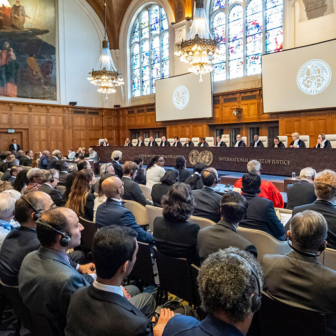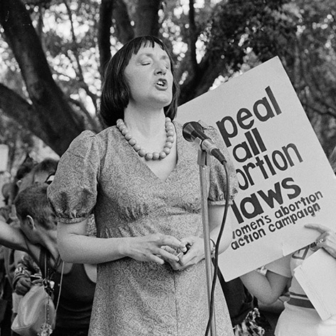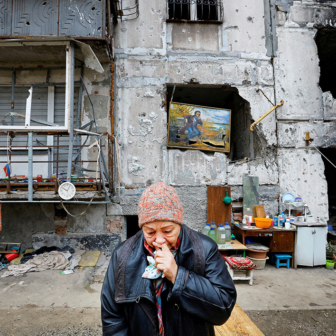AS THE EARTH was tilting its southern hemisphere towards summer in 2008, the president of Peru, Alan García, welcomed Kevin Rudd to the APEC meeting in Lima. There had already been some communication between the two: Sydney had been the last city to host APEC, and García had requested that the table the leaders had sat around be sent to Lima for use this time, which it was. García’s subsequent request for the security barriers that had been used in Sydney, though, was taken to be going a little too far and was politely declined.
The Peru that García put on show was culturally diverse: the country’s excellent and varied cuisine was served and the best of its many dances were performed for the visitors. It was all smiles and handshakes. Rudd even promised to reopen the Australian embassy in Lima, which had been closed down in 1986 when the violence of Peru’s turbulent internal conflict was escalating and when, incidentally, García had also been in power, that time as a young man.
The conflict in question – the conflict that Rudd now deemed to be over – was one of the bloodiest in contemporary Latin-American history. The Maoist insurgents – the Shining Path – sought to replace what they saw as Peru’s bourgeois democracy with New Democracy, an idea that, theoretically at least, many welcomed. At first the campesinos showed sympathy toward the guerrilleros, until they assassinated the local leaders of the campesinos’ communities as well as grassroots left-wing leaders in an effort to stamp out competition.
By the time García became president in 1985, the Peruvian government was only just beginning to take the guerrilleros seriously. The initial lack of concern about the Shining Path was the product of racism: the organisation was based in the mountains, a region populated mainly by indigenous people, rather than on the westernised coast. García may put his country’s cultural diversity on display for foreign guests, may boast about his country’s historical position as the centre of the Inka Empire, but he has at times belittled the most direct descendents of this heritage.
When the government eventually declared the regions of greatest activity an emergency zone, it granted the military the power to detain anyone “suspicious.” This fuelled xenophobia and led the military to arrest innocent campesinos, many of whom were subjected to torture and rape. The Truth and Reconciliation Commission’s report of 2003 estimates that 69,280 people lost their lives during the conflict. And most of them, of course, were the people caught in the middle, the campesinos.
Now that the conflict is considered to be over, Australia will once again have a presence in Peru, with the embassy due to open later this year. Yet traces of Peru’s internal conflict linger, and nowhere are these traces more apparent than in the actions of García.
The Moqueguazo
What has become known as the “Moqueguazo” began in March 2008 when it was revealed how much commerce tax the neighbouring regions of Tacna and Moquegua would receive from the companies exploiting their natural resources. For Tacna the tax meant an extra 711 million nuevos soles (about A$290 million), but for Moquegua the additional funds only amounted to 244 million nuevos soles, despite the fact that the latter produces more copper than its neighbour. Defenders of Moquegua’s interests announced that there would be a forty-eight-hour strike on 4 and 5 June, at which time Premier Jorge del Castillo acknowledged that their complaint was justified. But on 9 June, del Castillo retracted his earlier statement and declared that nothing could be done. Hours later, a strike of indefinite duration began, paralysing the region for ten days.
Protesters were mainly concentrated at the principal bridge of Moquegua, which they had blocked in order to immobilise the city. When the confrontation began to escalate, the chief of police, General Alberto Jordán, faced with two options, chose the peaceful one: he ordered his men to leave behind their weapons, saying that they would try to remedy the situation that had arisen when other police at the bridge had started using teargas without orders to do so. Once there, Jordán found the protesters furious, and convinced them to take him as a hostage, rather than his men.
Once Jordán was released, García acted. Instead of applauding Jordán’s diffusion of the situation, he called him a coward. And then, to the shock of the general populace, he relieved Jordán of his charge. García’s response revealed that the country’s internal conflict of the 1980s and 1990s was far from dormant.
In her article “La tentación del olvido: guerra, nacionalismo e historia en el Perú” (“The Temptation of Forgetting: War, Nationalism and History in Peru”), published in 2000 in Diálogos en historia, Cecilia Méndez G. wrote that a worrying consequence of Peru’s internal conflict was the extreme anti-terrorist attitude that prevailed among her compatriots at the time of her writing. She wondered why, and in what moment, the Shining Path, a Peruvian phenomenon, had been denationalised and branded un-Peruvian. She mentioned the general populace’s exuberant celebrations when fourteen hostage-takers were executed by the government at the residence of the Japanese ambassador to Peru in 1997 – some of them after their hostages had been successfully freed. Méndez G. interpreted these events as demonstrating that patriotism at all costs had created a predisposition for excusing violent acts of the government. She believed that fear of further internal conflict had made many willing to accept violent governmental reprisals against anyone who expressed discontent with the government.
Yet this predisposition of the general populace that so concerned Méndez G. has not been evident in recent years. The shocked reaction of Peruvians to Jordán’s dismissal shows that they neither expected nor desired a violent government reaction. When sacking Jordán, García expected that his people would excuse violent authoritarianism in their determination never again to be in the thrall of an internal conflict. And the Moqueguazo was the first incident in which García demonstrated that violent actions were all he would accept from his officials, that anything less would result in a sacking. It was the first time, in other words, that García demonstrated his inclination to implement violence against anyone he could construe as “terrorist,” in a misguided attempt to curry favour with his constituents.
The Bagua clash
In 2008 another protest was brewing in another part of the country, the Amazon, and this time the stance that García had adopted in the Moqueguazo would cost lives.
Prior to 1993, Peru was in the vanguard of countries protecting indigenous rights. The 1930 Constitution recognised the right of indigenous communities to their own land and gave them the autonomy to take care of their own affairs. But during the 1990s, President Alberto Fujimori ushered in neoliberal economic reforms, including a drastic privatisation crusade and free-market policies, which were in striking contrast to his campaign platform and even more radical than the opposition had proposed. This period saw the creation of the 1993 Constitution, which abolished the unalienable nature of the lands belonging to indigenous communities. Subsequent presidents have continued the slow withdrawal of many of their rights.
In 2008, García tried to introduce a series of decrees that became collectively known as the Law of the Jungle. The decrees were passed without consultation with the people they would affect, through special powers awarded to García by Congress, with the goal of having Peru meet rules set out in a free-trade agreement with the United States. Their purpose was to make it easier for companies to gain concessions for oil drilling, mining and logging by ensuring that the companies would not have to negotiate with local indigenous communities.
Protests by members of AIDESEP, the Peruvian Jungle Interethnic Development Association, which represents Peruvian Amazonians, began in late 2008, and gathered force in April 2009. Indigenous Amazonians shut down oil and gas pumping stations and blockaded road and river traffic, requesting that the Law of the Jungle be repealed.
García made it clear that he thought the indigenous Amazonians had failed to see that the decrees were a path to their own progress and betterment. After tolerating the protests for a few months, García said that it was time to put a stop to them. “These people,” he stated, “are not first-class citizens. What, can 400,000 natives say to twenty-eight million Peruvians, ‘You don’t have any right to come round here’? No way, that would be a grave error, and those who think that way want to lead us into irrationality and a backward, primitive state.”
In October 2008, the nation had been scandalised by recordings of conversations between high-ranking officials from the García administration and a lobbyist for transnational gas and oil companies, in which the men negotiated a bribe for the fraudulent concession of oil rights in natural reserves and indigenous territories. García knew exactly who would benefit from opening up the Amazon to oil and mineral exploitation, but he assumed that twenty-eight million Peruvians would naively believe that such exploitation would benefit the general populace as well.
To end the standoff, García had security forces break up a road blockade of 5000 peaceful protesters near Bagua. According to official reports, twenty-five people were killed, though locals say the figure was much higher. Protesters accused police of firing on them from helicopters while many of them were still asleep. García said the response was appropriate and blamed the indigenous Amazonians for thinking they could decide what happens in their territories. The police union declared that García used the police as cannon fodder to repress his own people.
A day after the Bagua clash, the government ordered the arrest of AIDESEP’s leader, Alberto Pizango, on charges of sedition and inciting violence – despite the fact that he was known to have pleaded with protesters to remain calm and had always attempted to keep them focused on their goal of opening up negotiations with the government regarding the Law of the Jungle. Nicaragua granted Pizango political asylum, but many of his people were killed before García backed down.
Less than two weeks after the confrontations, Congress voted overwhelmingly to revoke the decrees. And those twenty-eight million Peruvians who García said wanted order, who wanted the indigenous people’s requests refused and their protests silenced? The same people who Méndez G. had worried, less than ten years earlier, were showing a predisposition for excusing violent acts of the government? When making his statement about what he was convinced twenty-eight million Peruvians wanted, García glossed over the fact that a little over a month beforehand the entire country had been rocked by a national day of protest, when thousands took to the streets to express their solidarity with AIDESEP’s struggle. He ignored the massive march that had arrived at the steps of Congress, demanding that the Law of the Jungle be declared unconstitutional. But he was surely unable to ignore Peruvians’ discontent with his actions when, a month after the clashes, the workers’ union, teachers’ union and transportation union, among others, protested against the free-market policies of the García administration. School was cancelled and the train service was suspended.
García may show off – and with good reason – what his country has to offer. The Australian embassy may reopen in Lima on the basis that Peru’s internal conflict is over. But vestiges of the internal conflict remain glaringly apparent in the figure of García and in his political actions, which have become progressively more extreme. Pizango returned to Peru in May this year. Upon his arrival he was immediately arrested. Jordán, meanwhile, has been replaced as chief of police, and the new general knows what to do in the case of another Moqueguaso or Bagua. García’s actions have made that clear. •




